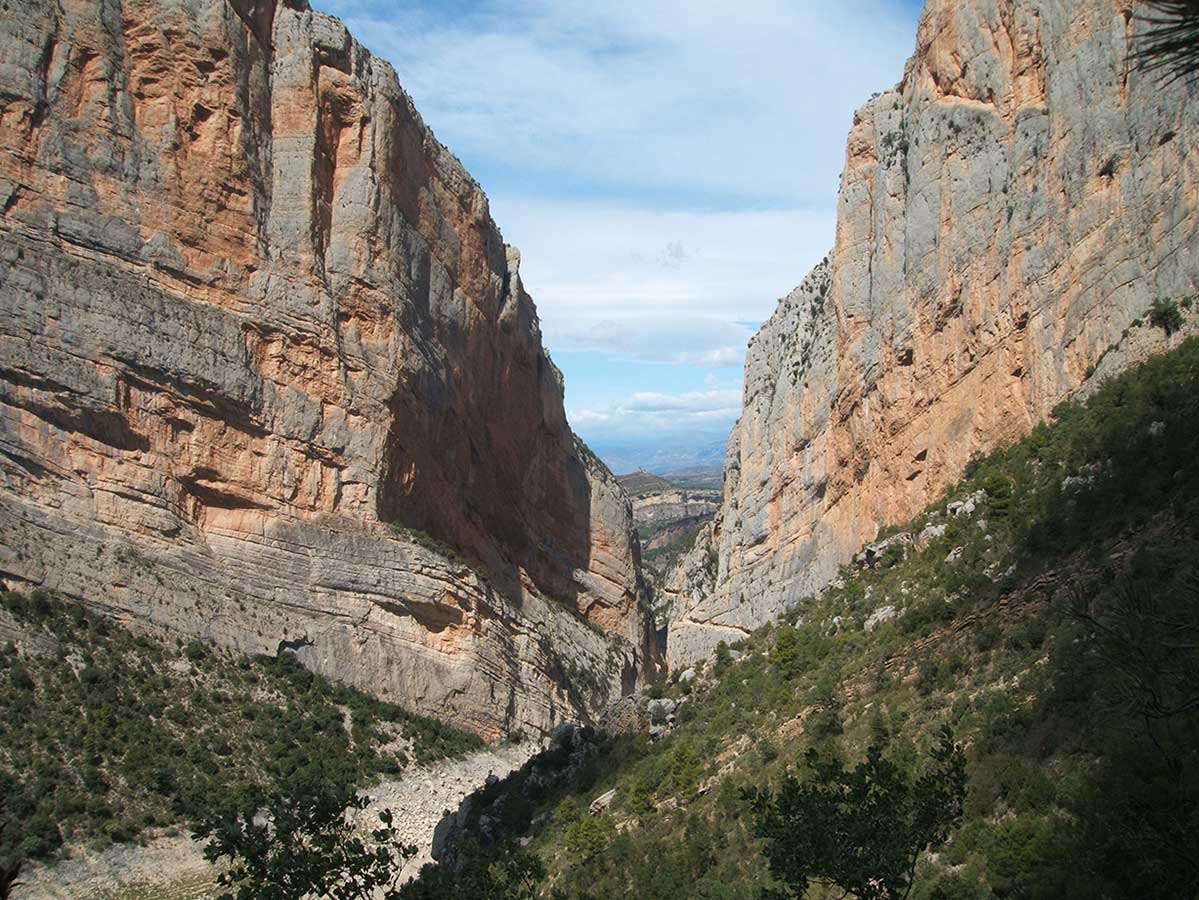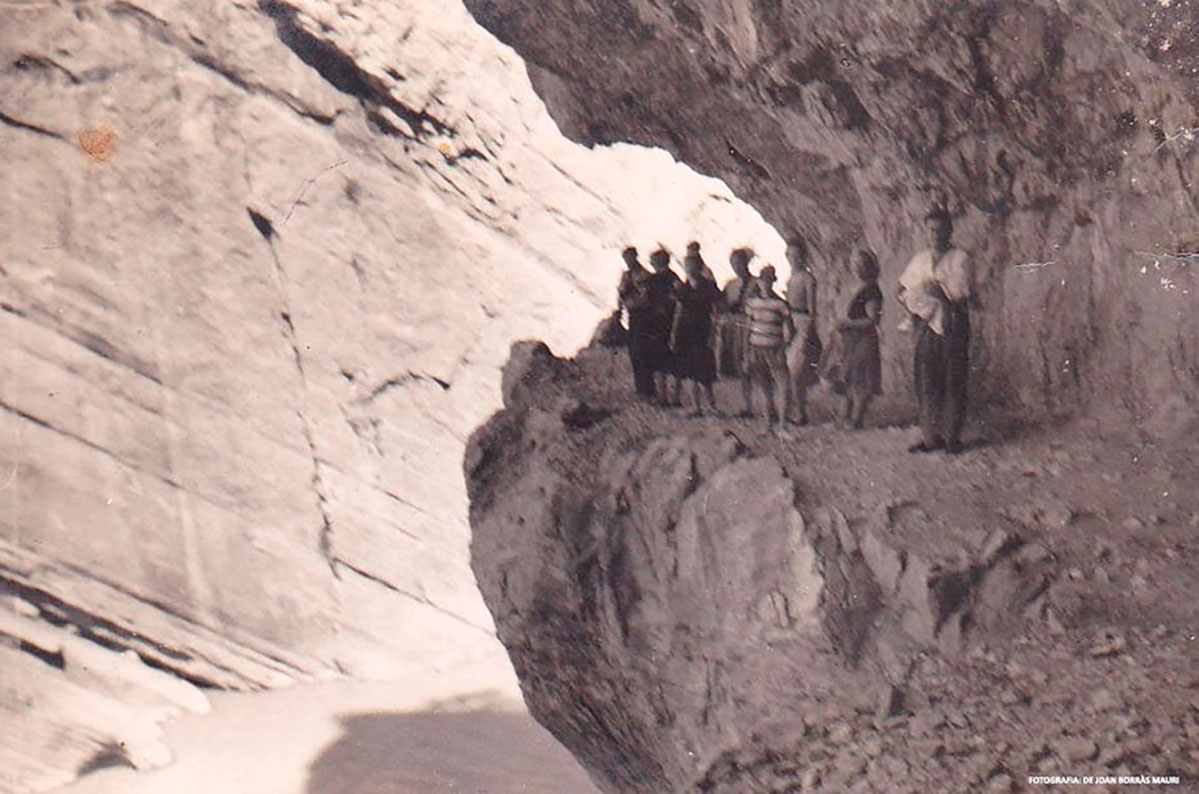
The Commonwealth path: pioneers among the rocks (1914-1924)

At the beginning of the twentieth century, the Mont-rebei Gorge was practically inaccessible. The vertical walls that separate the region of La Noguera and Pallars Jussà represented an insurmountable natural barrier for communications. At that time, the inhabitants of the area had to travel long mountain routes to get from one village to another, and in many cases, this meant hours—or even days—of travel.
With the aim of improving communication and promoting the economic development of mountain territories, the Mancomunitat de Catalunya, chaired by Enric Prat de la Riba and later by Josep Puig i Cadafalch, promoted several infrastructure projects throughout the country. One of these was the construction of a path through the Mont-rebei Gorge.
A heroic feat of engineering
Work began in 1914 and lasted until 1924. The modern machinery that we would consider essential today was not available. The path was opened by hand, with picks, hats and dynamite, following the natural ledges of the limestone rock. The workers, often hanging over the abyss with rudimentary ropes, managed to trace a passage about 4 km long and between 1 and 1.5 meters wide, dug directly into the wall of the gorge.
The construction was not only a technical feat, but also a human and social milestone, as it was a radical improvement in the daily lives of many inhabitants of the area, facilitating the transit of people, animals and goods.
A path for the people of the territory
This path was not designed for tourism, but for daily life: going to the market, visiting relatives, bringing livestock, accessing basic services. For decades, it was the only safe way to connect the two sides of Montsec. And despite its simplicity, it resisted the passage of time, floods and disuse, until the Canelles reservoir, in the 60s, partially submerged some sections.
Heritage and tourist value
Today, part of this historic route has been restored and is part of the main route of the Mont-rebei Gorge, which can be walked by hikers. Walking there is much more than a natural experience: it is also a journey to Catalonia a hundred years ago, when public works were driven by the ambition of connecting the country and dignifying rural life.
The original path of the Commonwealth has become a symbol of Catalan self-government, as it was one of the first major actions of this institution created to bring together the provincial councils and work for the modernization of the country.
With the construction of the Canelles reservoir in the mid-twentieth century, the landscape of the Mont-rebei Gorge changed forever. The new reservoir caused the partial flooding of the original Mancomunitat road, leaving sections impassable or submerged under the waters of the Noguera Ribagorçana river. Faced with this situation, it was necessary to find a new way that would allow communication and access to the area to be maintained.
The path of ENHER: fruit of the collective struggle (1980s)
The ENHER path is not only a technical response to the creation of the Canelles reservoir. It is, above all, the result of a persistent claim by the territory. When the reservoir was planned and built in the 60s and 70s, many residents were concerned about the disappearance of old paths, such as the Mancomunitat, which were vital for local mobility. The water cut off ancestral routes and carved the connection between peoples.
This situation generated deep unrest and, in response, various groups, hiking entities, cultural groups, town councils and residents began to mobilize to demand a solution.
A cross-cutting claim
For years, the following were involved:
- Hiking entities such as the Centre Excursionista de Lleida or the Agrupació Excursionista de Catalunya, which denounced the loss of historic paths.
- Neighbourhood and peasant platforms, which warned of the isolation of farmhouses, small towns and mountain areas.
- City councils and county councils, which demanded compensatory measures from ENHER and the State for the impact of the reservoir.
- Cultural associations and ecologists, who began to talk about the importance of preserving the Mont-rebei Gorge as a natural and cultural heritage.
A negotiated victory
Thanks to the sustained pressure of these actors, ENHER ended up taking on the construction of a new elevated road, which would avoid being affected by the waters of the reservoir and restore communication between the two banks. The initiative was partially presented as part of a project to maintain and manage the reservoir, but in reality it clearly responded to a citizen demand for territorial justice.
The construction of this new road was a small great victory: it showed that popular mobilization could condition the actions of a large state company, and at the same time preserved the continuity of a natural space of high landscape and social value.
From a demand to a tourist asset
Over time, this path has gone from being a practical necessity to becoming a first-class hiking route, integrated into the routes of the Congost de Mont-rebei GR1, Camí de la Pertusa and connected to the spectacular footbridges of Montfalcó, built years later. Today it is part of the Natural Path from Montfalcó to the Mont-rebei Gorge, within the state network of nature trails.
But all this would not have been possible without those voices that were raised from the villages, the entities and the mountains. The path of ENHER is not just a step; It is a mark of resistance, and walking it is paying homage to the struggle of a territory that defended its right to exist and connect.


